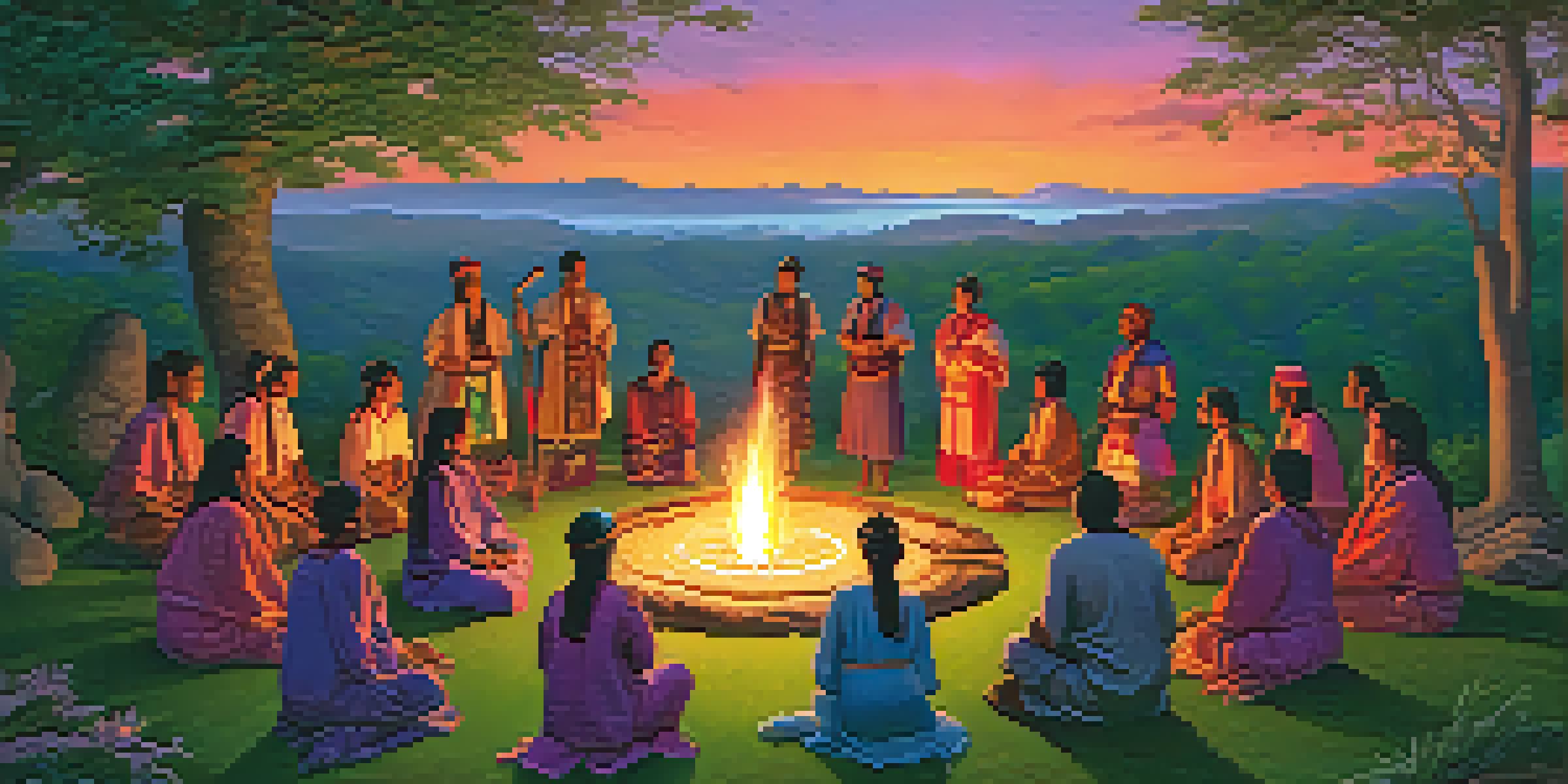Cultural Significance of Rituals in Hallucinogenic Use

Understanding Hallucinogens and Their Historical Context
Hallucinogens are substances that alter perception, mood, and cognitive processes. Historically, these substances have been used in various cultures for thousands of years. Indigenous tribes, for instance, have employed hallucinogens in their spiritual practices, believing that they can connect with the divine or gain insights about the universe.
The use of hallucinogens is often intertwined with rituals that give these experiences deeper meaning.
The use of hallucinogens is often intertwined with rituals that give these experiences deeper meaning. For example, the use of peyote in Native American ceremonies is not just about the drug itself but about the communal and spiritual experiences that accompany it. This historical context helps us appreciate the significance these substances hold in different cultures.
Understanding the historical backdrop of hallucinogens allows us to see why rituals are essential in shaping the experiences of users. They provide a framework that transforms a simple substance into a profound journey of self-discovery and connection with others.
Rituals: The Bridge Between the Physical and Spiritual
Rituals serve as a bridge, intertwining the physical act of consuming hallucinogens with the spiritual dimensions of the experience. These rituals often involve specific prayers, songs, or movements that guide participants through their journey. This structure not only enhances the experience but also fosters a sense of safety and community.

For many cultures, the act of preparing for a hallucinogenic experience is steeped in ritual. This might include cleansing the body and mind, setting intentions, and creating a sacred space. Such preparations allow participants to approach the experience with respect and mindfulness, deepening their connection to the ritual.
Cultural Significance of Rituals
Rituals transform hallucinogenic experiences into profound journeys of self-discovery and community connection.
By framing the hallucinogenic experience within a ritual, individuals can find meaning and context in their journeys. This sacred approach can lead to heightened insights and a lasting impact that transcends the immediate effects of the substance.
Community and Collective Experiences in Rituals
One of the standout aspects of hallucinogenic rituals is the communal experience they foster. When individuals engage in these practices together, they share not just in the substance but also in the journey. This collective aspect can strengthen social bonds and create a sense of belonging that is often missing in modern society.
Engaging in hallucinogenic rituals can provide various psychological benefits, including enhanced emotional well-being and improved mental clarity.
Imagine a group of people sitting together, each experiencing their own unique journey while still feeling a deep connection to one another. This shared experience can lead to profound insights about life, love, and the universe, reinforcing the idea that we are all in this together. It’s a reminder that, although our individual experiences may differ, the underlying emotions and revelations can unite us.
Community rituals often involve storytelling, where participants share their experiences and insights post-journey. This sharing not only validates individual experiences but also enriches the collective understanding of the ritual's significance.
The Role of Tradition in Hallucinogenic Rituals
Tradition plays a crucial role in how rituals involving hallucinogens are constructed and performed. Many cultures have established set practices that have been passed down through generations. These traditions often dictate how substances are used, when they are consumed, and the context in which they are experienced.
For example, in Amazonian cultures, the use of ayahuasca is embedded in intricate rituals that include singing, drumming, and the presence of a shaman. The shaman acts as a guide, ensuring that the participants navigate their experiences safely and meaningfully. This adherence to tradition helps preserve the cultural significance of the ritual.
Psychological Benefits of Rituals
Engaging in hallucinogenic rituals can enhance emotional well-being and foster healing in a supportive environment.
By maintaining these traditions, cultures ensure that the wisdom gained from hallucinogenic experiences is not lost. This continuity provides a framework for future generations to engage with these substances in a respectful and impactful manner.
Psychological Benefits of Ritualized Hallucinogenic Use
Engaging in hallucinogenic rituals can provide various psychological benefits, including enhanced emotional well-being and improved mental clarity. The structure of a ritual often helps individuals process their emotions and experiences more effectively. This can be especially valuable for those grappling with trauma or existential questions.
Studies suggest that participants in these rituals often report feelings of interconnectedness and healing. The communal aspects of these experiences can lead to a cathartic release, allowing participants to confront deep-seated issues in a supportive environment. It’s as if the ritual acts as a safety net, enabling exploration of challenging emotions.
Moreover, the psychological benefits are often long-lasting. Many individuals find that insights gained during these rituals translate into improved mental health and a more profound understanding of themselves and their place in the world.
Modern Adaptations of Hallucinogenic Rituals
As interest in hallucinogens grows in contemporary society, many traditions are being adapted for modern contexts. This has led to the emergence of new rituals that blend traditional practices with modern sensibilities. For example, some wellness retreats now incorporate hallucinogens into their programming, offering guided experiences that emphasize mindfulness and self-discovery.
While these modern adaptations can be beneficial, they often face criticism for commodifying sacred traditions. It’s essential to approach these practices with respect and awareness of their cultural origins. Striking a balance between innovation and tradition ensures that the core values of these rituals remain intact.
Modern Adaptations and Challenges
Contemporary adaptations of hallucinogenic rituals must balance innovation with respect for their cultural origins.
Ultimately, modern adaptations of hallucinogenic rituals can serve to introduce new audiences to their cultural significance. By maintaining a focus on the spiritual and communal aspects, these practices can continue to enrich lives in meaningful ways.
The Future of Rituals in Hallucinogenic Practices
Looking ahead, the future of rituals in hallucinogenic practices is both intriguing and uncertain. As societal norms evolve and the stigma around hallucinogens diminishes, we may see a resurgence of interest in traditional practices. This could lead to a revival of ancient rituals, potentially enriching contemporary spiritual practices.
On the other hand, the commercialization of these substances poses a risk to their cultural significance. As hallucinogens become more mainstream, there is a pressing need to educate users about the importance of respecting traditions and approaches that honor their origins. Without this awareness, the depth of these rituals could be lost.

In navigating this future, it’s crucial to foster dialogue between traditional practitioners and modern users. By sharing knowledge and respecting each other's experiences, we can ensure that the cultural significance of rituals in hallucinogenic use continues to thrive.